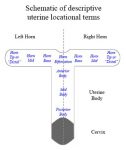Cessation of migration (fixation) of the embryonic vesicle
Is cessation of migration (fixation) of the embryonic vesicle inextricably linked to days 15-17 of pregnancy?
Introduction
The ability of the embryo to signal to the endometrium preventing the release of PGF2α and consequent luteolysis is believed to be dependent on its ability to move throughout the uterine lumen [1]. It might be assumed therefore that failure of this migration prior to luteolysis, might result in an inadequate luteostatic signal.
Materials and Methods
114 horse pregnancies were sequentially examined with ultrasound every 8 (+/-1) hours to determine the location of the embryonic vesicle within the uterine lumen.
 The lumen was arbitrarily divided into 10 locations viz. tip, mid and base of horns, bifurcation and anterior, mid, and posterior body, All mares had been examined at 8 hourly intervals at the time of ovulation so that the stage of pregnancy and the age of the vesicle was known to within +/- 4 hours. All inseminations were preovulation. Pregnancies where found as early as Day 10 and followed every 24hs until after the day of fixation, which was determined as the stage of pregnancy after which no further change of location was observed. Pregnancies in which embryonic loss occurred after cessation of migration were included in the data. Pregnancies which failed before cessation were excluded.
The lumen was arbitrarily divided into 10 locations viz. tip, mid and base of horns, bifurcation and anterior, mid, and posterior body, All mares had been examined at 8 hourly intervals at the time of ovulation so that the stage of pregnancy and the age of the vesicle was known to within +/- 4 hours. All inseminations were preovulation. Pregnancies where found as early as Day 10 and followed every 24hs until after the day of fixation, which was determined as the stage of pregnancy after which no further change of location was observed. Pregnancies in which embryonic loss occurred after cessation of migration were included in the data. Pregnancies which failed before cessation were excluded.
Results
Table 4 shows that while 59.2% of pregnancies ceased migration between 15 and 16 days post ovulation, 5 (4.9%) ceased at 13 days whilst 19 others (18.4%) continued to migrate after 16 and up to 18 days. Vesicle diameter did appear to be a possible factor since the mean diameters of vesicle which ceased migration was greater than the mean for all vesicles. Mean diameters of vesicles which subsequently failed (9.6%) was consistently less than the mean of all viable vesicles on all days. Failure was highest in vesicles which fixed at 13 and 14 days n=6 (54.5%) although in no instance was failure due to luteal regression.
Discussion
The day of fixation is variable between pregnancies. Fixation may be influenced by vesicle diameter but with notable exceptions. It is possible that both uterine diameter and contractility may also be factors. Most embryos ceased migration at or after the time of possible luteolysis. However, some 22% had ceased migration at or before 14 days post-ovulation, earlier than secretion of PGF would be seen in the non-pregnant mare but possibly later than the Maternal Recognition of Pregnancy Signal had been delivered [2]. It is possible therefore to assume that the mere presence of the embryo at this critical stage is normally sufficient to prevent luteolysis and that migration throughout the uterine lumen is not essential
References:
1: Ginther OJ (1983) Mobility of the early equine conceptus. Theriogenology 19:603-611
2: Timing of the Maternal Recognition of Pregnancy is Specific to Individual Mares. Newcombe JR, Cuervo-Arango J and Wilsher S (2023) ANIMALS 13;10:1718
© 2023 Professor John Newcombe, BVetMed, MRCVS




